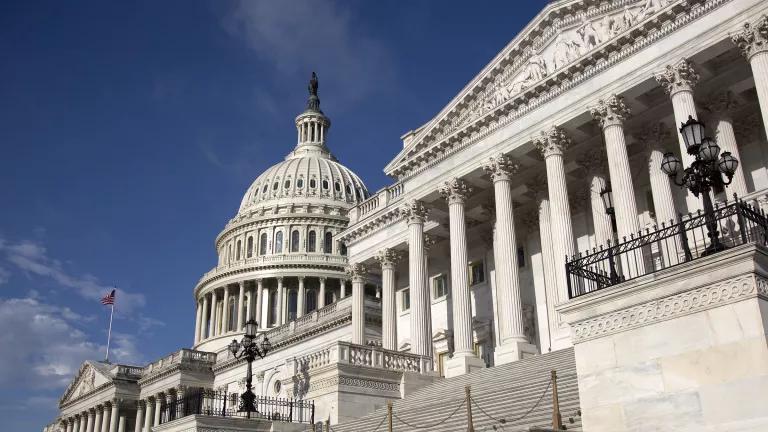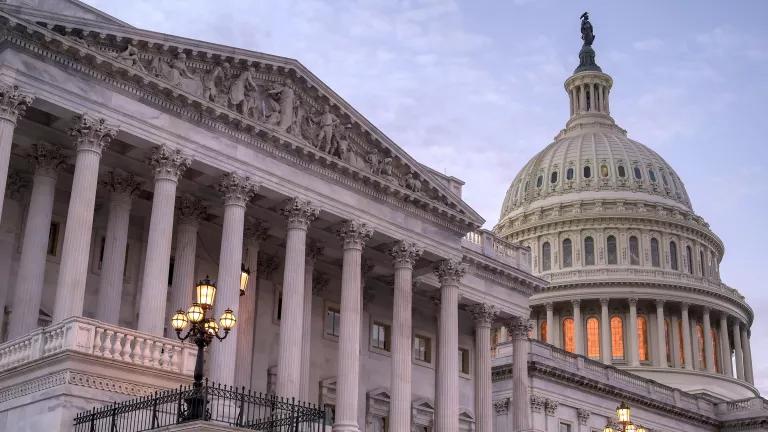Annual Defense Bill Nets Environmental & Public Health Gains
This year's bill contains significant wins for oceans, marine wildlife, public lands and Tribal equity, and public health.
Congress once again passed the National Defense Authorization Act (NDAA) into law. The annual NDAA is among Congress’s most reliable bipartisan efforts. In fact, it is the only annual legislation in Congress with a perfect track record of consecutive enactment dating back 62 years. But don’t be fooled: Passage of the NDAA is a massive undertaking each year. Its size and complexity require bill authors to reach agreements on numerous issues across congressional committees. Although the chief focus of the NDAA is national defense, the bill’s negotiators on House Armed Services committee and other jurisdictional committees spend countless hours negotiating provisions with significant environmental and public health implications. Thanks to the hard work of key congressional leaders, this year’s final agreement for fiscal year 2023 (FY23) contains substantial environmental wins for oceans, marine wildlife, public lands, tribal equity, and public health. Read on for the highlights.
Oceans and marine wildlife
Oceans and marine wildlife saw significant wins in the FY23 NDAA through a series of provisions that define opportunities for better environmental protections across the nation, including national security. The U.S. Department of Defense (DOD) operates across significant ocean areas, impacting numerous ecosystems and species. Ship collisions, activity, and chronic vessel noise are among the principal threats contributing to the decline of some of the most endangered marine mammals, including Southern Resident orca whales whose habitat overlaps with one of the Pacific Northwest’s busiest vessel traffic areas. Congressional negotiators advanced provisions in the final NDAA that seek to reduce the impacts of vessels on marine mammals in conjunction with others focused on improving our national marine mammal stranding-and-response program that helps rescue and rehabilitate these creatures. This provision will make it easier for vessels and whales to coexist by scaling innovative technological solutions, creating support to build off of proven models of success, and investing in delivering vessels that are both quiet and carbon-free.
Additionally, this year’s final NDAA made headway in addressing illegal, unreported, and unregulated (IUU) fishing activities and forced labor in the fishing and seafood sector—an issue that, if left unchecked, undermines national security, economic competitiveness, and fisheries sustainability. The bill contains provisions that significantly expand and improve the High Seas Driftnet Fishing Moratorium Protection Act, one of the few tools used to combat IUU fishing and forced labor in international fisheries, including heightened sanctions for nations that fail to address IUU fishing, and a directive for National Oceanic and Atmospheric Administration (NOAA) and partner agencies to expand capacity-building initiatives with source countries. The NDAA also provides $20 million in annual appropriations funding to support enforcement of section 307 of the Tariff Act, which bans imports of goods, including seafood, made with forced labor. Additionally, it makes improvements to NOAA’s Seafood Import Monitoring Program to help improve its function and enforcement as a screening tool for IUU seafood entering the United States, while prioritizing screening and enforcement for seafood produced with forced labor or human trafficking.
Other ocean provisions retained in the final FY23 NDAA include a ban on shark fin sales in the United States, authorization of Regional Ocean Partnerships, and protection forresilient coral reefs, to name a few.
Tribal equity on public lands
The 2023 NDAA includes language to equitably expand the U.S. Navy’s Fallon air station in Nevada. Like many of the federally managed lands in the state, the Fallon region is utilized by the DOD for military training activities and live-fire operations that support key national security objectives. At the same time, Fallon sits in Nevada’s high desert landscape, an environment that is home to delicate ecosystems, unique wildlife, and multiple Indigenous nations who have lived on these lands for millennia.
Already the Bureau of Land Management has a complicated mandate to balance environmental conservation and cultural preservation with competing activities that are permitted on Nevada’s federal lands, including mining, grazing, and gaming in addition to what is utilized by DOD. At Fallon in particular, the Fallon Paiute Shoshone and Walker River Tribes’ ancestral and aboriginal lands have been directly impacted by DOD’s training operations there, degrading their quality and ways of life.
As the training needs of the U.S. Navy have evolved, NDAA negotiators, in partnership with the U.S. Department of the Interior, Nevada congressional members, and U.S. Navy leadership, successfully included language that was crafted over years of discussions with diverse stakeholders. The U.S. Navy will receive the expanded use of lands it sought, and the tribes will receive dedicated lands and resources that will be specially managed to protect and preserve sustained tribal knowledge, culture, and identity. The agreement also provides tribes the meaningful opportunity to comment on the development of required resource management planning processes that aim to conserve environmental and cultural resources. The final agreement is a recognition that it is possible to advance military readiness while also protecting this critical environment.
Toxic chemicals and health
This year’s final NDAA retained several provisions that continue to address contamination from highly toxic PFAS chemicals. Found in firefighting foams and consumer goods, PFAS are man-made chemicals that do not break down in the environment and are linked to serious health outcomes, including cancer, development and reproductive harms, hormone disruption, and immune system disorders. In previous years, the DOD has begun to make modest progress to limit the public’s and military service members’ exposure to PFAS, though far more needs to be done. As a significant user of PFAS, the DOD’s strong implementation of the policies in the current and past NDAAs would help demonstrate the department’s commitment to protecting the health of military service members and the public.
Provisions in this year’s package will help to limit the use of firefighting turnout gear that has historically contained PFAS through prizes incentivizing the development of gear alternatives that are PFAS-free and by restricting the DOD’s procurement or purchases of PFAS-containing turnout gear for firefighters. Other provisions target sources and uses of PFAS, including an annual report on contamination at military installations separate from aqueous film-forming firefighting foams, and reporting on critical PFAS uses coupled with briefings on the DOD’s procurement of certain items containing two PFAS that are most widely used, PFOA and PFOS.
While the FY23 NDAA builds on the work DOD has already undertaken, there are still opportunities to do more. Several provisions were included in previous House-passed versions of the NDAA or were proposed for inclusion in the current bill but ultimately didn’t make it into the final agreement. These provisions offer a starting place for future action. The first was a mandate passed in the House bill for states to follow stricter state cleanup standards for PFAS contamination, which would help ensure that less PFAS make their way into drinking water and potentially into food sources and adversely impact public health. Also left on the cutting room floor was a provision requiring the U.S. Environmental Protection Agency (EPA) to update its definition of PFAS to cover a broader scope of these chemicals under requirements to report use. As it is currently written, EPA’s definition narrows the types of PFAS that are considered under these requirements, thereby limiting the knowledge of their potential effects on drinking water, food, and public health. Additional measures that were carried in the House-passed bill this year but were not in the final FY23 NDAA would have required DOD to evaluate non-incineration technologies to destroy PFAS, and required EPA to issue effluent limitation guidelines, standards, and water quality criteria for PFAS, applicable to certain categories of polluters. Congress should continue to look for ways to advance these and other protections in future legislation next year.
Process fouls not permitted
It’s worth noting that this year’s NDAA did not pass without controversy. In the lead-up to the final vote, there was a last-minute effort to insert a hotly disputed permitting language as an amendment to the NDAA. Under the guise of speeding up the permitting process for energy projects, the permitting language would instead deprive environmental justice and frontline communities of a meaningful voice in permitting decisions for pipelines and other fossil fuel infrastructure; let these dirty energy projects short-circuit environmental and public health safeguards; and radically reduce the time frame for seeking federal court review when these projects cause damage—all without meaningfully addressing the root causes of permitting delays. Additionally, the legislation would rubber-stamp the Mountain Valley Pipeline, a gas project that was illegally approved by agencies under the Trump administration.
In the end, the amendment failed to garner the necessary votes to pass, in part due to the successful work of a broad coalition of environmental and environmental justice organizations to block this controversial proposal. The NDAA’s unblemished record of enactment is due to its long-standing deliberative and bipartisan process; contentious last-minute airdrops need not apply.




